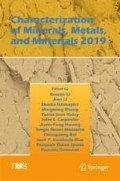Abstract
The complex of single-layered molybdenum disulfide and graphene were widely used for capacitor field due to its better stability skeleton, higher specific surface area and conductivity. The morphology and electrochemical performance of the complex with special emphasizing effect of the amounts of graphene , volume ratio of water and ethanol in the solvent were investigated by XRD , SEM and Cyclic Voltammetry test in this work. The XRD and SEM results demonstrated that the loose flower-like spherical molybdenum disulfide could be successful synthesized at a reaction temperature of 200 °C for 24 h, a molybdenum–sulfur ratio of 1:28. And the flower-like spheroidal molybdenum disulfide was further grown on the reduced graphene oxide skeleton. It was found that the specific capacitance reached 45.4 F/g through the cyclic voltammetry test when the solvent is water. Through the AC impedance test, it was found that the addition of rGO improved the conductivity of molybdenum disulfide .
Access this chapter
Tax calculation will be finalised at checkout
Purchases are for personal use only
References
Raghu MS, Kumar KY, Rao S et al (2018) Simple fabrication of reduced graphene oxide -few layer MoS2 nanocomposite for enhanced electrochemical performance in supercapacitors and water purification. Phys B 537:336–345
Choi M, Hwang J, Setiadi H et al (2017) One-pot synthesis of molybdenum disulfide reduced graphene oxide (MoS2-RGO) composites and their high electrochemical performance as an anode in lithium ion batteries. J Supercrit Fluids 127:81–89
Patil UM, Nam MS, Kang S et al (2016) Fabrication of ultra-high energy and power asymmetric supercapacitors based on hybrid 2D MoS2/graphene oxide composite electrodes: a binder-free approach. RSC Adv 6(49):43261–43271
Sun T, Liu X, Li Z et al (2017) Graphene-wrapped CNT@MoS2 hierarchical structure: synthesis, characterization and electrochemical application in supercapacitors. New J Chem 41(15):7142–7150
Zhuang Y-T, Zhang X, Wang D-H et al (2018) Three-dimensional molybdenum disulfide/graphene hydrogel with tunable heterointerfaces for high selective Hg(II) scavenging. J Colloid Interface Sci 514:715–722
Govindasamy M, Chen SM, Mani V et al (2017) Nanocomposites composed of layered molybdenum disulfide and graphene for highly sensitive amperometric determination of methyl parathion. Microchim Acta 184(3):725–733
Li X, Zhang C, Xin S et al (2016) Facile synthesis of MoS2/reduced graphene oxide@polyaniline for high-performance supercapacitors. ACS Appl Mater Interfaces 8(33):21373–21380
Sun T, Li Z, Liu X et al (2016) Facile construction of 3D graphene/MoS2 composites as advanced electrode materials for supercapacitors. J Power Sources 331:180–188
Bissett MA, Kinloch IA, Dryfe RAW (2015) Characterization of MoS2-graphene composites for high-performance coin cell supercapacitors. ACS Appl Mater Interfaces 7(31): 7388–17398
Haitao X, Xiaopeng X (2017) A porous molybdenum disulfide and reduced graphene oxide nanocomposite (MoS2-rGO) with high adsorption capacity for fast and preferential adsorption towards Congo red. J Environ Chem Eng 5(1):1150–1158
Acknowledgements
The authors acknowledge the financial support provided by the National Science Fund of China (No. 51674225, No. 51774252), the Innovative Talents Foundation in Universities in Henan Province (No. 18HASTIT011), the Educational Commission of Henan Province of China (No. 17A450001, 18A450001), and the China Postdoctoral Science Foundation (No. 2017M622375).
Author information
Authors and Affiliations
Corresponding authors
Editor information
Editors and Affiliations
Rights and permissions
Copyright information
© 2019 The Minerals, Metals & Materials Society
About this paper
Cite this paper
Han, G., Wang, W., Huang, Y., Duan, Y., Peng, W. (2019). Synthesis and Electrochemical Properties of Molybdenum Disulfide/Graphene Composites. In: Li, B., et al. Characterization of Minerals, Metals, and Materials 2019. The Minerals, Metals & Materials Series. Springer, Cham. https://doi.org/10.1007/978-3-030-05749-7_25
Download citation
DOI: https://doi.org/10.1007/978-3-030-05749-7_25
Published:
Publisher Name: Springer, Cham
Print ISBN: 978-3-030-05748-0
Online ISBN: 978-3-030-05749-7
eBook Packages: Chemistry and Materials ScienceChemistry and Material Science (R0)

